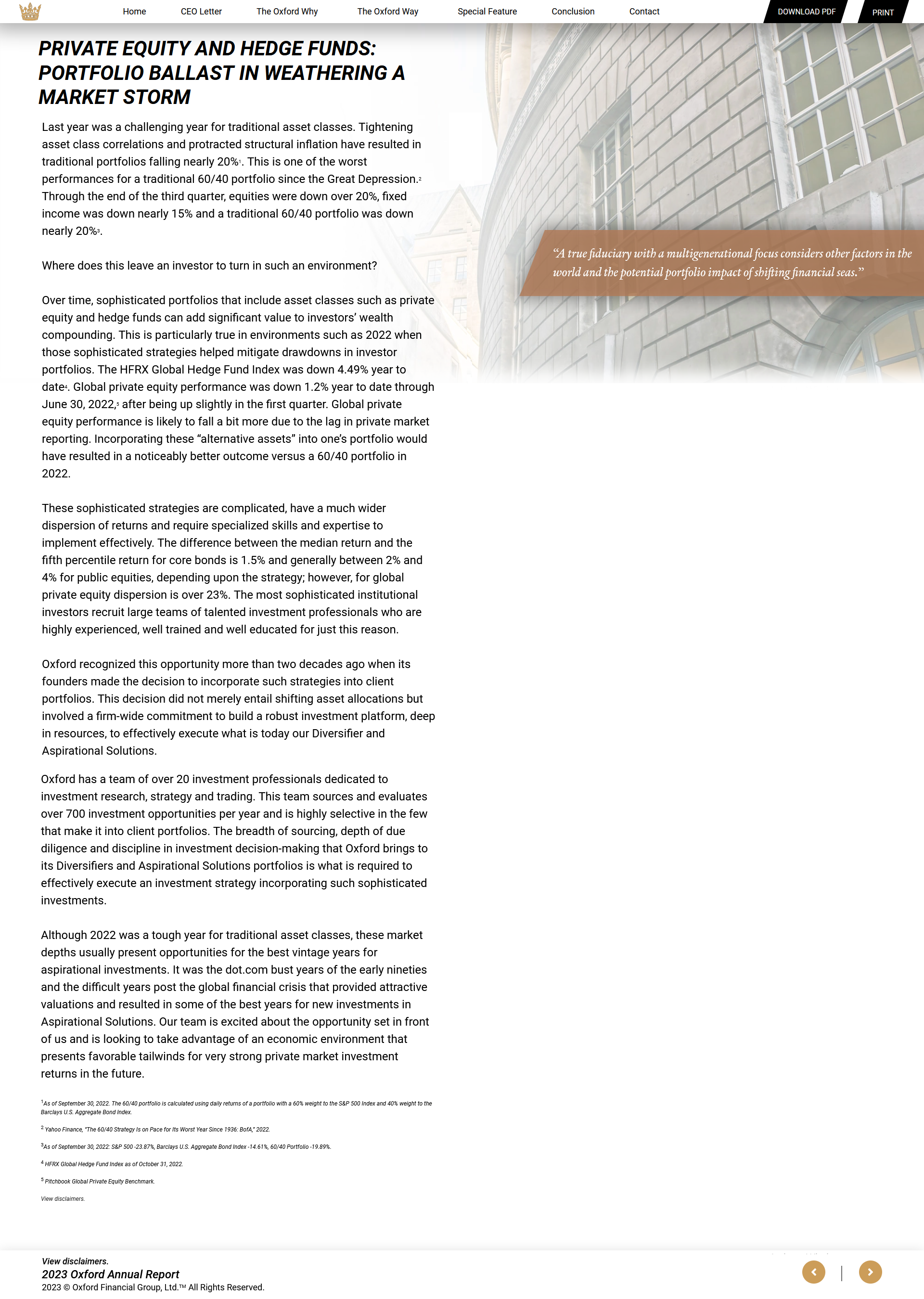PRIVATE EQUITY AND HEDGE FUNDS: PORTFOLIO BALLAST IN WEATHERING A MARKET STORM
Last year was a challenging year for traditional asset classes. Tightening asset class correlations and protracted structural inflation have resulted in traditional portfolios falling nearly 20%.1 This is one of the worst performances for a traditional 60/40 portfolio since the Great Depression.2 Through the end of the third quarter, equities were down over 20%, fixed income was down nearly 15% and a traditional 60/40 portfolio was down nearly 20%.3
Where does this leave an investor to turn in such an environment?
Over time, sophisticated portfolios that include asset classes such as private equity and hedge funds can add significant value to investors’ wealth compounding. This is particularly true in environments such as 2022 when those sophisticated strategies helped mitigate drawdowns in investor portfolios. The HFRX Global Hedge Fund Index was down 4.49% year to date.4 Global private equity performance was down 1.2% year to date through June 30, 2022,5 after being up slightly in the first quarter. Global private equity performance is likely to fall a bit more due to the lag in private market reporting. Incorporating these “alternative assets” into one’s portfolio would have resulted in a noticeably better outcome versus a 60/40 portfolio in 2022.
These sophisticated strategies are complicated, have a much wider dispersion of returns and require specialized skills and expertise to implement effectively. The difference between the median return and the fifth percentile return for core bonds is 1.5% and generally between 2% and 4% for public equities, depending upon the strategy; however, for global private equity dispersion is over 23%. The most sophisticated institutional investors recruit large teams of talented investment professionals who are highly experienced, well trained and well educated for just this reason.
Oxford recognized this opportunity more than two decades ago when its founders made the decision to incorporate such strategies into client portfolios. This decision did not merely entail shifting asset allocations but involved a firm-wide commitment to build a robust investment platform, deep in resources, to effectively execute what is today our Diversifier Strategies and Aspirational Solutions.
Oxford has a team of over 20 investment professionals dedicated to investment research, strategy and trading. This team sources and evaluates over 700 investment opportunities per year and is highly selective in the few that make it into client portfolios. The breadth of sourcing, depth of due diligence and discipline in investment decision-making that Oxford brings to its Diversifier Strategies and Aspirational Solutions portfolios is what is required to effectively execute an investment strategy incorporating such sophisticated investments.
Although 2022 was a tough year for traditional asset classes, these market depths usually present opportunities for the best vintage years for aspirational investments. It was the dot.com bust years of the early nineties and the difficult years post the global financial crisis that provided attractive valuations and resulted in some of the best years for new investments in Aspirational Solutions. Our team is excited about the opportunity set in front of us and is looking to take advantage of an economic environment that presents favorable tailwinds for very strong private market investment returns in the future.
1As of September 30, 2022. The 60/40 portfolio is calculated using daily returns of a portfolio with a 60% weight to the S&P 500 Index and 40% weight to the Barclays U.S. Aggregate Bond Index.
2 Yahoo Finance, “The 60/40 Strategy Is on Pace for Its Worst Year Since 1936: BofA,” 2022.
3As of September 30, 2022: S&P 500 -23.87%, Barclays U.S. Aggregate Bond Index -14.61%, 60/40 Portfolio -19.89%.
4 HFRX Global Hedge Fund Index as of October 31, 2022.
5 Pitchbook Global Private Equity Benchmark.
“A true fiduciary with a multigenerational focus considers other factors in the world and the potential portfolio impact of shifting financial seas.”

